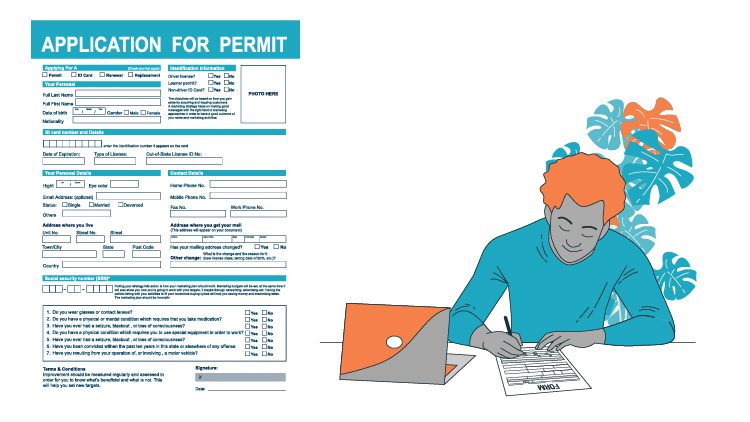
Who Needs to File Form I-212?
If you have been previously deported, removed, or otherwise found inadmissible to the United States, you may need to file a Form I-212 to return to the country. This form is the Application for Permission to Reapply for Admission into the United States After Deportation or Removal. It is designed to allow individuals found inadmissible to return to the U.S. after some time or after addressing any immigration violations or negative factors that contributed to their inadmissibility. If you are subject to a removal proceeding or have already been deported, you will likely need to file an I-212 Waiver before returning to the United States. This waiver will allow you to seek permission to return, even if you were removed due to grounds of inadmissibility.
In many cases, the release will also require evidence of rehabilitation or other mitigating factors that demonstrate your ability to comply with immigration law in the future. When filing Form I-212, providing all necessary documentation to support your case is essential. This may include evidence of extreme hardship to family members who are U.S. citizens or lawful permanent residents, family responsibility in the United States, or other compelling factors that support your request to be readmitted. You may also need to provide evidence of rehabilitation or steps to address any immigration violations or negative factors contributing to your inadmissibility. If you need to file Form I-212, you should know the application has a filing fee. This fee can be paid by personal check or credit card and is payable at the time of filing. Additionally, it would be best if you were prepared to undergo a visa interview and provide additional evidence as requested by USCIS or the consular office where you will apply for a nonimmigrant visa.
Overall, suppose you are seeking to return to the United States after previous deportation or removal. In that case, it is essential to understand the I-212 application process and to work with an experienced immigration attorney to prepare your case and provide the necessary evidence to support your request for readmission.
When to File Form I-212
If you have been removed or deported from the United States, you must file Form I-212 to seek permission to re-enter the country. This applies to those ordered dismissed by an immigration judge, deported by the U.S. government, or left the U.S. under a grant of voluntary departure. It is important to note that even if you were removed from the United States and did not receive a formal order of removal or deportation, you may still need to file Form I-212 if you plan on returning to the country. This applies if you were stopped at a port of entry and returned to a foreign country. The process of filing Form I-212 can be complex, so it is recommended to consult with an experienced immigration attorney. They can help determine if you need to file Form I-212 and when is the best time to do so. Filing too early or too late could impact your chances of obtaining permission to re-enter the United States. It is essential to keep in mind that filing Form I-212 does not guarantee approval to re-enter the country. The U.S. government will consider several factors, including the reason for your previous removal or deportation, your current circumstances, and your ties to the United States.
In some cases, you may be required to demonstrate that your re-entry is in the best interest of the United States. This may require additional documentation or evidence to support your case. An immigration attorney can assist in gathering and presenting this information. Overall, it is crucial to carefully consider when to file Form I-212 if you seek permission to re-enter the United States after a previous removal or deportation. Consulting with an immigration attorney can help you navigate the process successfully and increase your chances of a favorable outcome.
How to File Form I-212
Now that you know who needs to file Form I-212 and when it should be filed, it's time to look into the steps required to file the form.
- Obtain a Copy of the Form
The first step in the process is to obtain a copy of the Form I-212. This form is accessible on the USCIS website to download and print it.
- Fill Out the Form Completely
Once you have the form in hand, the next step is to fill it out completely and accurately. Ensuring that all the information on the form is correct and up-to-date is essential.
- Submit the Form with the Appropriate Fee
After filling out the form, you must submit it with the appropriate fee. The fee for Form I-212 varies depending on the situation, so make sure to check the USCIS website for the latest fee information.
- Include Supporting Documents
You may also need to submit supporting documents along with the form and fee. These documents could include proof of your relationship to a U.S. citizen or legal permanent resident or evidence that you have lived outside the U.S. for some time.
- Wait for a Decision
After submitting Form I-212 and any required supporting documents, you must wait for a decision from USCIS. This decision can take a few weeks to several months, so it's essential to be patient and prepared for a potentially lengthy process.
Following these steps, you can successfully file Form I-212 and return to the United States. Remember, this form is only one step in a much larger process, so knowing all the requirements and timelines is essential.
What Happens After Filing Form I-212?
After filing Form I-212, several things may happen depending on your situation. First, you will receive a receipt notice from USCIS indicating that your form has been received and is being processed. This notice will provide you with a case number, which you can use to track the status of your application online. Next, USCIS will review your case to determine whether or not you meet the eligibility criteria for admission or re-entry to the United States. If USCIS determines that you do not meet these criteria, your application may be denied, and you may be barred from entering the United States for a specific period. If your application is approved, you will receive a letter of approval from USCIS. This letter will provide instructions on what to do next, including how to obtain any necessary travel documents and schedule your visa interview (if required). If your application is denied, you may be able to file an appeal or request a waiver of the inadmissibility grounds. It is essential to seek the advice of an experienced immigration attorney if your application is denied, as the appeal and waiver process can be complex and challenging to navigate without legal guidance.
Overall, the Form I-212 process can be lengthy and complex, but with careful preparation and the help of an experienced immigration attorney, you can increase your chances of success. Remember to file your form on time, provide all required documentation and information, and seek the advice of an attorney if you encounter any obstacles or challenges along the way.
What Are the Penalties for Not Filing Form I-212?
The consequences for not filing Form I-212 can be severe. First and foremost, if you are found inadmissible, you may be barred from entering the United States for a certain period. This can range from a few years to a lifetime ban, depending on the circumstances of your case.
Additionally, you could be detained or removed from the country if you attempt to enter the United States without the necessary approval. This can result in being separated from your family and losing your job or other important aspects of your life. Not filing Form I-212 can also have long-term consequences. Even if you can eventually enter the United States, you may find obtaining certain benefits or privileges, such as permanent residency or citizenship, complicated. It's important to understand that filing Form I-212 is not just a legal requirement but a way to protect your future opportunities and prevent further consequences. If you are unsure about whether you need to file this form, it's recommended that you consult with an experienced immigration attorney who can advise you on your specific case.
Frequently Asked Questions
Form I-212 is an application for permission to reapply for admission. It is used by individuals previously deported, excluded, or removed from the U.S. and seeking permission to return.
In some cases, you may be able to request expedited processing of Form I-212 if you can demonstrate an urgent need or exceptional circumstances. However, USCIS generally has strict criteria for expediting applications, and not all requests are granted.
To file Form I-212, you must complete the form with accurate information, provide the required supporting documentation, and pay the filing fee. The completed form and supporting documents must be mailed to the appropriate USCIS office.
The specific supporting documents may vary depending on individual circumstances. Still, generally, you will need to provide evidence of your eligibility for admission, such as your passport, birth certificate, and proof of ties to the U.S. You may also need to submit documents explaining the circumstances of your removal or deportation.
As of my knowledge cutoff date is September 2021, and the filing fee for Form I-212 is $930. However, USCIS fees can change over time, so you must check the USCIS website or consult an immigration attorney for the most up-to-date fee information.
https://www.universal-translation-services.com/everything-you-need-to-know-about-the-form-i-212-process/


Comments
Post a Comment